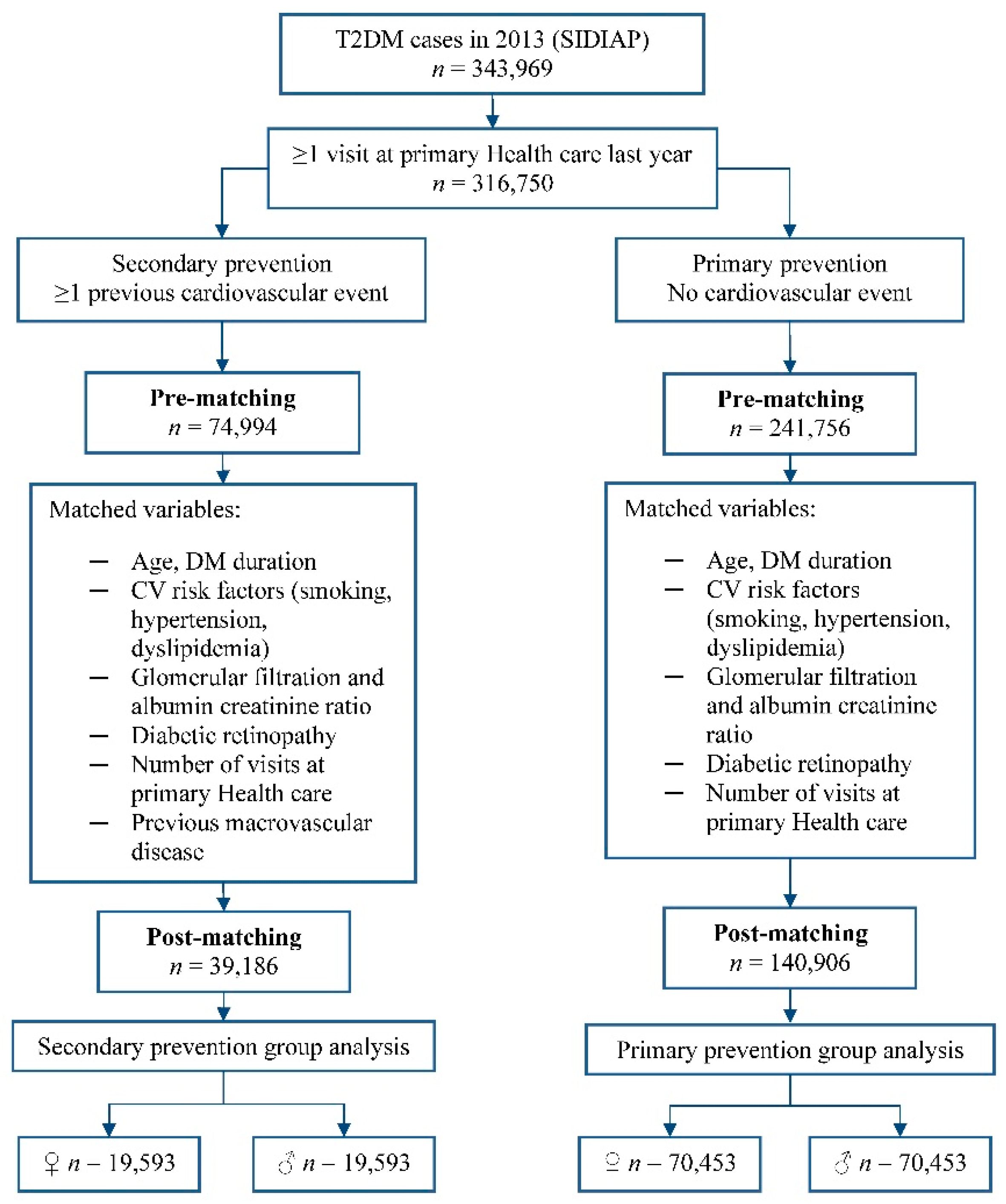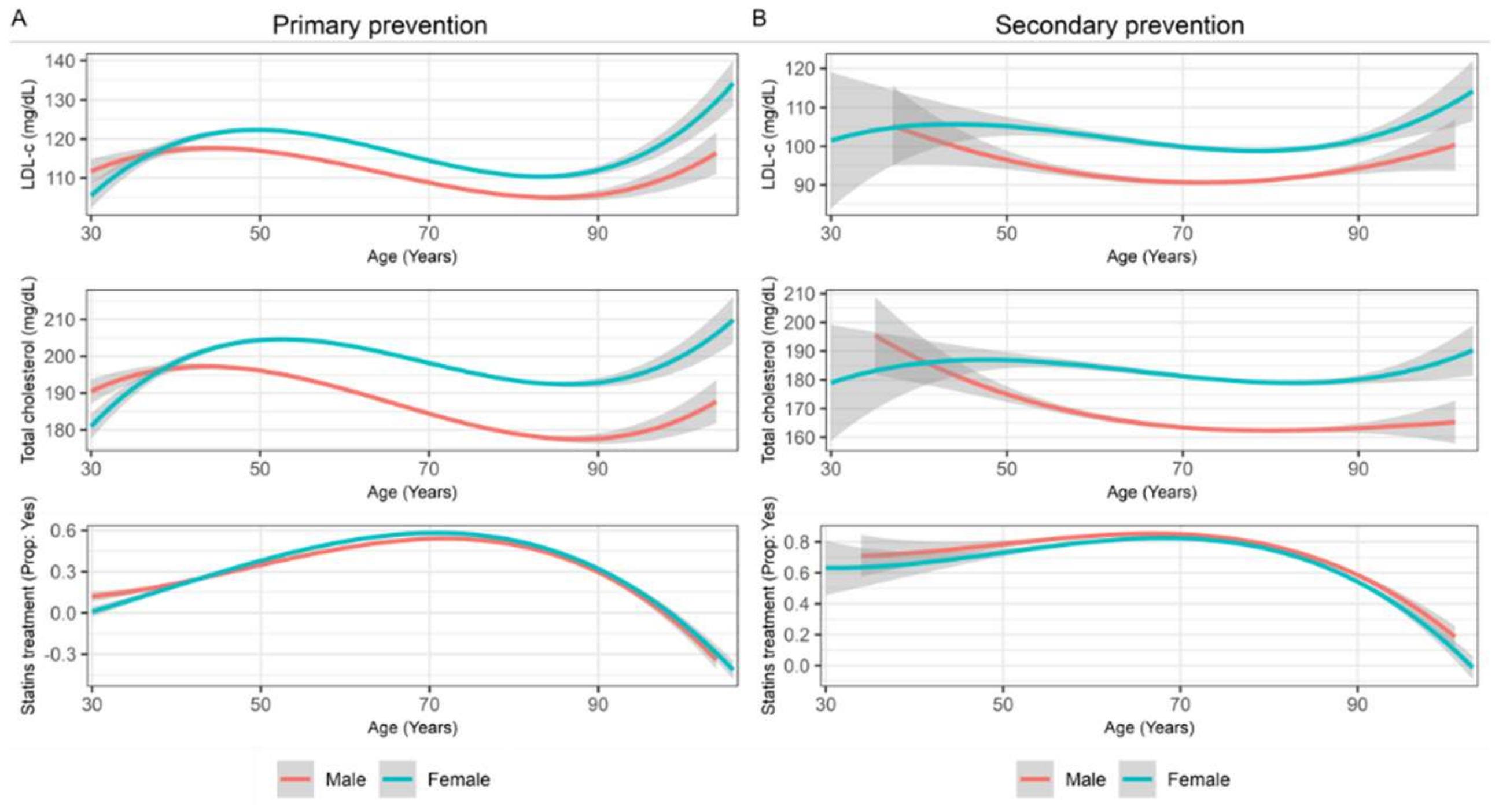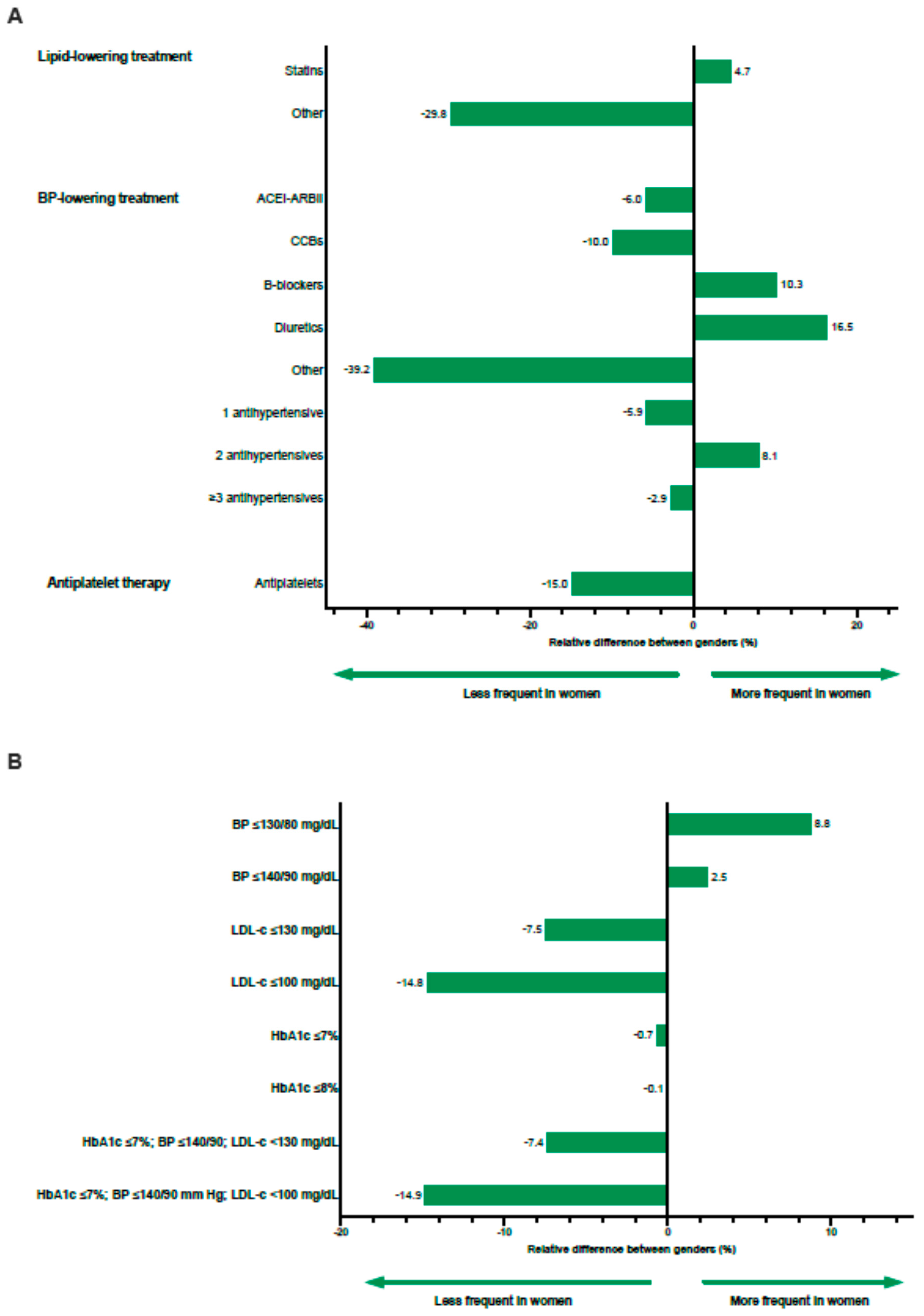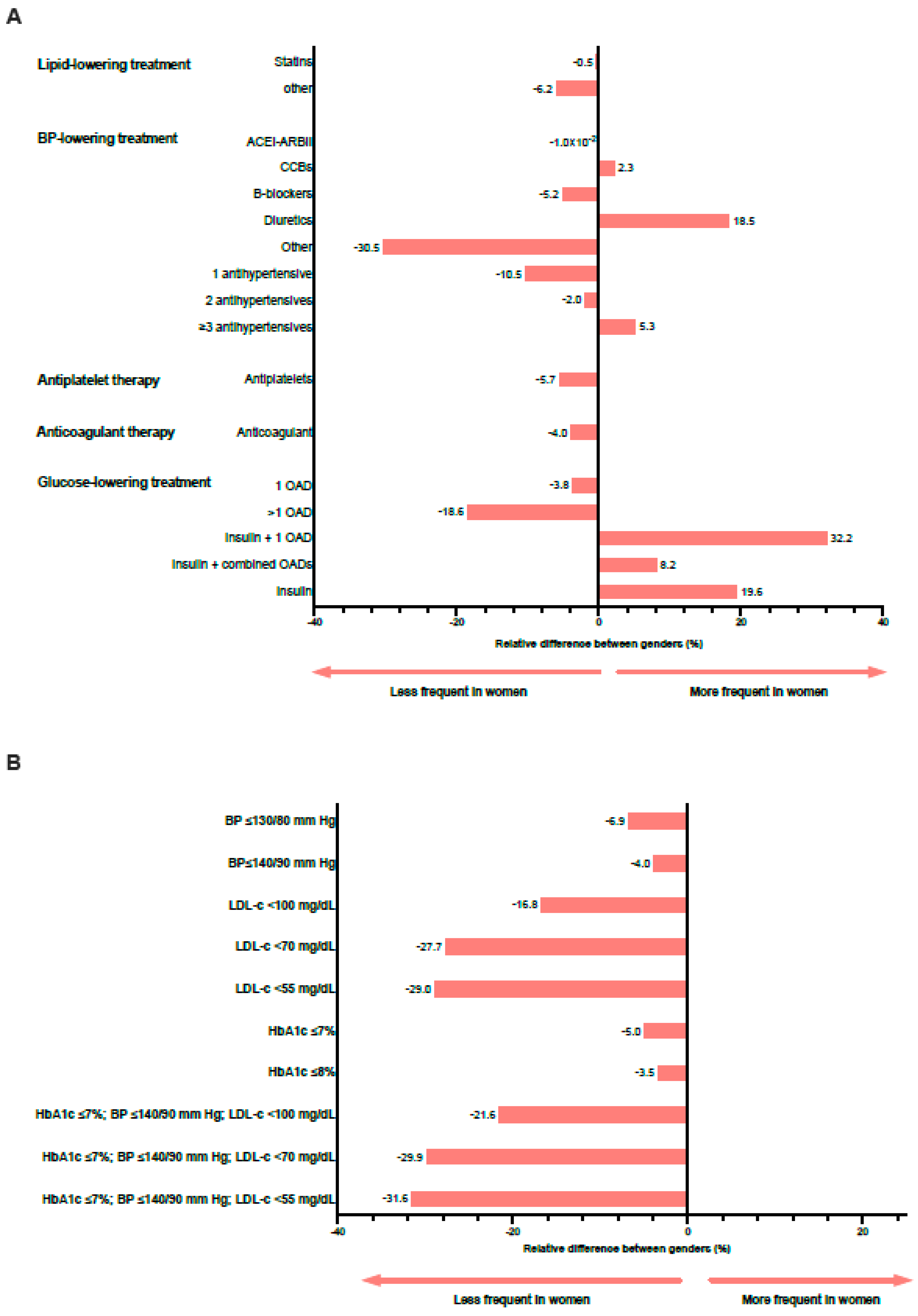Sex Differences in Cardiovascular Prevention in Type 2: Diabetes in a Real-World Practice Database
Abstract
1. Introduction
2. Materials and Methods
2.1. Study Design
2.2. Study Variables
2.3. Propensity Score Matching Method
2.4. Statistical Analysis
3. Results
3.1. Primary Prevention
3.2. Secondary Prevention
4. Discussion
5. Conclusions
Supplementary Materials
Author Contributions
Funding
Institutional Review Board Statement
Informed Consent Statement
Data Availability Statement
Acknowledgments
Conflicts of Interest
References
- International Diabetes Federation (IDF). IDF Diabetes Atlas: Ninth Edition 2019. Available online: https://www.diabetesatlas.org (accessed on 2 March 2020).
- de Ritter, R.; de Jong, M.; Vos, R.C.; van der Kallen, C.J.H.; Sep, S.J.S.; Woodward, M.; Stehouwer, C.D.A.; Bots, M.L.; Peters, S.A.E. Sex Differences in the Risk of Vascular Disease Associated with Diabetes. Biol. Sex Differ. 2020, 11, 1. [Google Scholar] [CrossRef] [PubMed]
- Kautzky-Willer, A.; Harreiter, J.; Pacini, G. Sex and Gender Differences in Risk, Pathophysiology and Complications of Type 2 Diabetes Mellitus. Endocr. Rev. 2016, 37, 278–316. [Google Scholar] [CrossRef] [PubMed]
- Peters, S.A.E.; Woodward, M. Sex Differences in the Burden and Complications of Diabetes. Curr. Diab. Rep. 2018, 18, 33. [Google Scholar] [CrossRef] [PubMed]
- Huebschmann, A.G.; Huxley, R.R.; Kohrt, W.M.; Zeitler, P.; Regensteiner, J.G.; Reusch, J.E.B. Sex Differences in the Burden of Type 2 Diabetes and Cardiovascular Risk across the Life Course. Diabetologia 2019, 62, 1761–1772. [Google Scholar] [CrossRef] [PubMed]
- Hyun, K.K.; Redfern, J.; Patel, A.; Peiris, D.; Brieger, D.; Sullivan, D.; Harris, M.; Usherwood, T.; MacMahon, S.; Lyford, M.; et al. Gender Inequalities in Cardiovascular Risk Factor Assessment and Management in Primary Healthcare. Heart 2017, 103, 492–498. [Google Scholar] [CrossRef] [PubMed]
- Eapen, Z.J.; Liang, L.; Shubrook, J.H.; Bauman, M.A.; Bufalino, V.J.; Bhatt, D.L.; Peterson, E.D.; Hernandez, A.F. Current Quality of Cardiovascular Prevention for Million Hearts: An Analysis of 147,038 Outpatients from The Guideline Advantage. Am. Heart J. 2014, 168, 398–404. [Google Scholar] [CrossRef]
- Ares Blanco, J.; Valdés Hernández, S.; Botas, P.; Rodríguez-Rodero, S.; Morales Sánchez, P.; Díaz Naya, L.; Menéndez-Torre, E.; Delgado, E. Diferencias de Género en la Mortalidad de Personas con Diabetes Tipo 2: Estudio Asturias 2018. Gac. Sanit. 2019, 34, 442–448. [Google Scholar] [CrossRef]
- Vinagre, I.; Mata-Cases, M.; Hermosilla, E.; Morros, R.; Fina, F.; Rosell, M.; Castell, C.; Franch-Nadal, J.; Bolíbar, B.; Mauricio, D. Control of Glycemia and Cardiovascular Risk Factors in Patients with Type 2 Diabetes in Primary Care in Catalonia (Spain). Diabetes Care 2012, 35, 774–779. [Google Scholar] [CrossRef]
- Franch-Nadal, J.; Mata-Cases, M.; Vinagre, I.; Patitucci, F.; Hermosilla, E.; Casellas, A.; Bolivar, B.; Mauricio, D. Differences in the Cardiometabolic Control in Type 2 Diabetes According to Gender and the Presence of Cardiovascular Disease: Results from the Econtrol Study. Int. J. Endocrinol. 2014, 2014, 131709. [Google Scholar] [CrossRef]
- Gómez García, M.C.; Franch-Nadal, J.; Millaruelo Trillo, J.M.; Cos-Claramunt, F.X.; Avila Lachica, L.; Buil Cosiales, P. Control Glucémico y de los Factores de Riesgo Cardiovascular en los Pacientes Con Diabetes Tipo 2 con Enfermedad Cardiovascular en España, y su Patrón de Tratamiento, en Función del Género: Estudio CODICE. Med. Fam. Semer. 2019, 46, 125–135. [Google Scholar] [CrossRef]
- Gómez García, M.C.; Millaruelo Trillo, J.M.; Avila Lachica, L.; Cos-Claramunt, F.X.; Franch-Nadal, J.; Cortés Gil, X. Estudio ESCRYTO. Diabetes sin Enfermedad Cardiovascular y Grado de Control. Med. Fam. Semer. 2019, 46, 261–269. [Google Scholar] [CrossRef] [PubMed]
- Rosenbaum, P.R. The Central Role of the Propensity Score in Observational Studies for Causal Effects. Biometrika 1983, 70, 41–55. [Google Scholar] [CrossRef]
- Mata-Cases, M.; Vlacho, B.; Real, J.; Puig-Treserra, R.; Bundó, M.; Franch-Nadal, J.; Mauricio, D. Trends in the Degree of Control and Treat ment of Cardiovascular Risk Factors in People With Type 2 Diabetes in a Primary Care Setting in Catalonia During 2007–2018. Front. Endocrinol. 2022, 12, 810757. [Google Scholar] [CrossRef] [PubMed]
- Institut Català de la Salut. Estàndard de Qualitat de Prescripció Farmacèutica 2021. Available online: http://ics.gencat.cat/web/web/.content/documents/assistencia/31052021_EQPF-2021-GLOBAL-i-MFiC-versio-4.pdf (accessed on 4 April 2022).
- Bolíbar, B.; Fina Avilés, F.; Morros, R.; del Mar Garcia-Gil, M.; Hermosilla, E.; Ramos, R.; Rosell, M.; Rodríguez, J.; Medina, M.; Calero, S.; et al. Base de Datos SIDIAP: La Historia Clínica Informatizada de Atención Primaria como Fuente de Información para la Investigación Epidemiológica. Med. Clin. 2012, 138, 617–621. [Google Scholar] [CrossRef]
- Mata-Cases, M.; Franch-Nadal, J.; Real, J.; Mauricio, D. Glycaemic Control and Antidiabetic Treatment Trends in Primary Care Centres in Patients with Type 2 Diabetes Mellitus during 2007–2013 in Catalonia: A Population-Based Study. BMJ Open 2016, 6, e012463. [Google Scholar] [CrossRef][Green Version]
- Mata-Cases, M.; Cos, F.X.; Morros, R.; Diego, L.; Barrot, J.; Berengué, M.; Brugada, M.; Carrera, T.; Cano, J.F.; Estruch, M.; et al. Abordatge de la Diabetis Mellitus Tipus 2, 2nd ed.; Guies de pràctica clínica i material docent, núm 15; Institut Català de la Salut: Barcelona, Spain, 2013; Available online: http://hdl.handle.net/11351/4514 (accessed on 2 March 2022).
- Ho, D.E.; Imai, K.; King, G.; Stuart, E.A. MatchIt: Nonparametric Preprocessing for Parametric Causal Inference. J. Stat. Softw. 2011, 42, 8. [Google Scholar] [CrossRef]
- de Jong, M.; Oskam, M.J.; Sep, S.J.S.; Ozcan, B.; Rutters, F.; Sijbrands, E.J.G.; Elders, P.J.M.; Siegelaar, S.E.; DeVries, J.H.; Tack, C.J.; et al. Sex Differences in Cardiometabolic Risk Factors, Pharmacological Treatment and Risk Factor Control in Type 2 Diabetes: Findings from the Dutch Diabetes Pearl Cohort. BMJ Open Diabetes Res. Care 2020, 8, e001365. [Google Scholar] [CrossRef]
- Logue, J.; Walker, J.J.; Colhoun, H.M.; Leese, G.P.; Lindsay, R.S.; McKnight, J.A.; Morris, A.D.; Pearson, D.W.; Petrie, J.R.; Philip, S.; et al. Scottish Diabetes Research Network Epidemiology Group. Do Men Develop Type 2 Diabetes at Lower Body Mass Indices than Women? Diabetologia 2011, 54, 3003–3006. [Google Scholar] [CrossRef]
- Paul, S.; Thomas, G.; Majeed, A.; Khunti, K.; Klein, K. Women Develop Type 2 Diabetes at a Higher Body Mass Index than Men. Diabetologia 2012, 55, 1556–1557. [Google Scholar] [CrossRef]
- Woodward, M.; Peters, S.A.E.; Huxley, R.R. Diabetes and the Female Disadvantage. Womens. Health 2015, 11, 833–839. [Google Scholar] [CrossRef]
- Ambrož, M.; de Vries, S.T.; Vart, P.; Dullaart, R.P.F.; Roeters van Lennep, J.; Denig, P.; Hoogenberg, K. Sex Differences in Lipid Profile across the Life Span in Patients with Type 2 Diabetes: A Primary Care-Based Study. J. Clin. Med. 2021, 10, 1775. [Google Scholar] [CrossRef] [PubMed]
- Mascarenhas-Melo, F.; Marado, D.; Palavra, F.; Sereno, J.; Coelho, Á.; Pinto, R.; Teixeira-Lemos, E.; Teixeira, F.; Reis, F. Diabetes Abrogates Sex Differences and Aggravates Cardiometabolic Risk in Postmenopausal Women. Cardiovasc. Diabetol. 2013, 12, 61. [Google Scholar] [CrossRef] [PubMed]
- Rossi, M.C.; Cristofaro, M.R.; Gentile, S.; Lucisano, G.; Manicardi, V.; Mulas, M.F.; Napoli, A.; Nicolucci, A.; Pellegrini, F.; Suraci, C.; et al. Sex Disparities in the Quality of Diabetes Care: Biological and Cultural Factors May Play a Different Role for Different Outcomes: A Cross-Sectional Observational Study from the AMD Annals Initiative. Diabetes Care 2013, 36, 3162–3168. [Google Scholar] [CrossRef] [PubMed]
- Virani, S.S.; Woodard, L.D.; Ramsey, D.J.; Urech, T.H.; Akeroyd, J.M.; Shah, T.; Deswal, A.; Bozkurt, B.; Ballantyne, C.M.; Petersen, L.A. Gender Disparities in Evidence-Based Statin Therapy in Patients with Cardiovascular Disease. Am. J. Cardiol. 2015, 115, 21–26. [Google Scholar] [CrossRef]
- Nanna, M.G.; Wang, T.Y.; Xiang, Q.; Goldberg, A.C.; Robinson, J.G.; Roger, V.L.; Virani, S.S.; Wilson, P.W.F.; Louie, M.J.; Koren, A.; et al. Sex Differences in the Use of Statins in Community Practice: Patient and provider assessment of lipid management registry. Circ. Cardiovasc. Qual. Outcomes 2019, 12, e005562. [Google Scholar] [CrossRef]
- Lewey, J.; Shrank, W.H.; Bowry, A.D.K.; Kilabuk, E.; Brennan, T.A.; Choudhry, N.K. Gender and Racial Disparities in Adherence to Statin Therapy: A Meta-Analysis. Am. Heart J. 2013, 165, 665–678.e1. [Google Scholar] [CrossRef]
- de Jong, M.; Vos, R.C.; de Ritter, R.; van der Kallen, C.J.; Sep, S.J.; Woodward, M.; Stehouwer, C.D.A.; Bots, M.L.; Peters, S.A. Sex Differences in Cardiovascular Risk Management for People with Diabetes in Primary Care: A Cross-Sectional Study. BJGP Open 2019, 3, bjgpopen19X101645. [Google Scholar] [CrossRef]
- The Look AHEAD Research Group. Cardiovascular Effects of Intensive Lifestyle Intervention in Type 2 Diabetes. N. Engl. J. Med. 2013, 369, 145–154. [Google Scholar] [CrossRef]
- Harreiter, J.; Kautzky-Willer, A. Sex and Gender Differences in Prevention of Type 2 Diabetes. Front. Endocrinol. 2018, 9, 220. [Google Scholar] [CrossRef]
- Sasso, F.C.; Pafundi, P.C.; Simeon, V.; De Nicola, L.; Chiodini, P.; Galiero, R.; Rinaldi, L.; Nevola, R.; Salvatore, T.; Sardu, C.; et al. Efficacy and Durability of Multifactorial Intervention on Mortality and MACEs: A Randomized Clinical Trial in Type-2 Diabetic Kidney Disease. Cardiovasc. Diabetol. 2021, 20, 145. [Google Scholar] [CrossRef]
- Austin, P.C. The Performance of Different Propensity Score Methods for Estimating Marginal Hazard Ratios. Stat. Med. 2013, 32, 2837–2849. [Google Scholar] [CrossRef] [PubMed]
- Austin, P.C. The Performance of Different Propensity-Score Methods for Estimating Relative Risks. J. Clin. Epidemiol. 2008, 61, 537–545. [Google Scholar] [CrossRef] [PubMed]
- Austin, P.C. The Performance of Different Propensity Score Methods for Estimating Marginal Odds Ratios. Stat. Med. 2007, 26, 3078–3094. [Google Scholar] [CrossRef] [PubMed]
- Cebrián-Cuenca, A.M.; Mata-Cases, M.; Franch-Nadal, J.; Mauricio, D.; Orozco-Beltrán, D.; Consuegra-Sánchez, L. Half of Patients with Type 2 Diabetes Mellitus Are at Very High Cardiovascular Risk According to the ESC/EASD: Data from a Large Mediterranean Population. Eur. J. Prev. Cardiol. 2022, 28, e32–e34. [Google Scholar] [CrossRef] [PubMed]
- Garcia-Moll, X.; Barrios, V.; Franch-Nadal, J. Moving from the Stratification of Primary and Secondary Prevention of Cardiovascular Risk in Diabetes towards a Continuum of Risk: Need for a New Paradigm. Drugs Context 2021, 10, 2021-6-3. [Google Scholar] [CrossRef] [PubMed]




| Variable | N Subjects | Women | N Subjects | Men | Dif | 95% CI | |
|---|---|---|---|---|---|---|---|
| Age (years), mean ± SD * | 70,453 | 66.57 ± 12.22 | 70,453 | 65.88 ± 12.20 | 0.69 | 0.63 | 0.75 |
| Diabetes duration (years), mean ± SD * | 7.10 ± 5.40 | 7.01 ± 5.34 | 0.09 | 0.07 | 0.12 | ||
| Number of visits, mean ± SD *,† | 6.39 ± 4.66 | 6.18 ± 5.08 | 0.21 | 0.19 | 0.24 | ||
| Smoking habit, n (%) * | 69,001 | 69,119 | |||||
| Nonsmoker | 51,753 (75.00) | 51,118 (73.96) | 1.04 | 0.67 | 1.42 | ||
| Smoker | 7684 (11.14) | 5934 (8.59) | 2.55 | 2.29 | 2.81 | ||
| Former smoker | 9564 (13.86) | 12,067 (17.46) | −3.60 | −3.90 | −3.30 | ||
| BMI (kg/m2), mean ± SD | 48,047 | 31.09 ± 5.80 | 47,287 | 29.34 ± 4.47 | 1.75 | 1.72 | 1.78 |
| HbA1c (%), mean ± SD | 54,055 | 7.24 ± 1.37 | 53,476 | 7.22 ± 1.37 | 0.02 | 0.01 | 0.03 |
| Dyslipidemia, n (%) * | 70,453 | 37,367 (53.04) | 70,453 | 36,264 (51.47) | 1.57 | 1.13 | 2.00 |
| Lipid profile (mg/dL), mean ± SD | |||||||
| Total cholesterol | 54,561 | 199.02 ± 37.71 | 53,976 | 186.89 ± 37.16 | 12.13 | 11.91 | 12.35 |
| HDL-c | 49,918 | 53.76 ± 13.35 | 48,986 | 47.53 ± 12.15 | 6.23 | 6.15 | 6.31 |
| LDL-c | 116.10 ± 32.62 | 110.60 ± 31.29 | 5.50 | 5.30 | 5.70 | ||
| TGs | 51,514 | 152.23 ± 90.36 | 50,830 | 153.70 ± 110.82 | −1.47 | −2.09 | −0.85 |
| Hypertension, n (%) * | 70,453 | 47,968 (68.09) | 70,453 | 45,949 (65.22) | 2.87 | 2.46 | 3.27 |
| Blood Pressure (mmHg), mean ± SD | 59,795 | 59,067 | |||||
| dBP | 75.95 ± 8.35 | 76.44 ± 8.62 | −0.49 | −0.54 | −0.44 | ||
| sBP | 133.83 ± 13.25 | 134.86 ± 12.56 | −1.03 | −1.10 | −0.96 | ||
| Diabetic retinopathy, n (%) * | 70,453 | 4418 (6.27) | 70,453 | 4485 (6.37) | −0.10 | −0.29 | 0.10 |
| Renal disease, n (%) *,$ | 53,782 | 8617 (16.02) | 53,493 | 8409 (15.72) | 0.30 | −0.06 | 0.66 |
| Variable | N Subjects | Women | N Subjects | Men | Dif (95% CI) |
|---|---|---|---|---|---|
| Lipid-lowering treatment, n (%) * | 37,367 | 36,264 | |||
| Statins | 34,933 (93.49) | 32,374 (89.27) | 4.22 (3.91/4.52) | ||
| Other | 4653 (12.45) | 6430 (17.73) | −5.28 (−5.69/−4.87) | ||
| Antihypertensive treatment, n (%) † | 47,968 | 45,949 | |||
| ACEI/ARBII | 38,757 (80.80) | 39,492 (85.95) | −5.15 (−5.54/−4.76) | ||
| CCBs | 13,477 (28.10) | 14,352 (31.23) | −3.13 (−3.60/−2.68) | ||
| Beta-blockers | 9893 (20.62) | 8586 (18.69) | 1.93 (1.53/2.34) | ||
| Diuretics | 31,429 (65.52) | 25,836 (56.23) | 9.29 (8.80/9.79) | ||
| Other | 2570 (5.36) | 4054 (8.82) | −3.46 (−3.69/−3.24) | ||
| Number of drugs | |||||
| 1 | 16,124 (33.61) | 16,404 (35.70) | −2.09 (−2.61/−1.57) | ||
| 2 | 18,593 (38.76) | 16,479 (35.86) | 2.90 (2.40/3.40) | ||
| ≥3 | 13,251 (27.62) | 13,066 (28.44) | −0.82 (−1.27/−0.35) | ||
| Antiplatelet therapy, n (%) | 70,453 | 14,993 (21.28) | 70,453 | 17,645 (25.05) | −3.77 (−4.12/−3.41) |
| Target CVRF achievement, n (%) | |||||
| BP ≤ 130/80 mmHg | 59,795 | 20,442 (34.19) | 59,067 | 18,558 (31.42) | 2.77 (2.32/3.22) |
| BP ≤ 140/90 mmHg | 44,555 (74.51) | 42,955 (72.72) | 1.79 (1.38/2.21) | ||
| LDL-c ≤ 130 mg/dL | 49,918 | 34,707 (69.53) | 48,986 | 36,831 (75.19) | −5.66 (−6.14/−5.18) |
| LDL-c ≤ 100 mg/dL | 16,661 (33.38) | 19,213 (39.22) | −5.84 (−6.35/−5.34) | ||
| HbA1c, % | 54,055 | 53,476 | |||
| ≤7 | 30,262 (55.98) | 30,152 (56.38) | −0.40 (−0.91/0.11) | ||
| ≤8 | 43,269 (80.05) | 42,767 (79.97) | 0.08 (−0.32/0.47) | ||
| >8 | 10,786 (19.95) | 10,709 (20.03) | −0.08 (−0.47/0.32) | ||
| HbA1c ≤ 7%, BP ≤ 140/90 mmHg, LDL-c < 130 mg/dL | 43,956 | 13,173 (29.97) | 42,788 | 13,863 (32.40) | −2.43 (−2.96/−1.90) |
| HbA1c ≤ 7%, BP ≤ 140/90 mmHg, LDL-c < 100 mg/dL | 5935 (13.50) | 6787 (15.86) | −2.36 (−2.74/−1.98) |
| Variable | N Subjects | Women | N Subjects | Men | Dif | 95% CI | |
|---|---|---|---|---|---|---|---|
| Age (years), mean ± SD * | 19,593 | 75.39 ± 9.99 | 19,593 | 74.38 ± 9.73 | 1.01 | 0.91 | 1.11 |
| Diabetes duration (years), mean ± SD * | 9.41 ± 6.50 | 9.19 ± 6.27 | 0.22 | 0.16 | 0.29 | ||
| Number of visits, mean ± SD *,† | 8.58 ± 5.99 | 8.34 ± 6.45 | 0.24 | 0.03 | 0.30 | ||
| Smoking habit, n (%) * | 19,324 | 19,342 | |||||
| Nonsmoker | 16,389 (84.81) | 16,230 (83.91) | 0.90 | 0.26 | 1.54 | ||
| Smoker | 958 (4.96) | 740 (3.83) | 1.13 | 0.79 | 1.48 | ||
| Former smoker | 1977 (10.23) | 2372 (12.26) | −2.03 | −2.57 | −1.50 | ||
| BMI (kg/m2), mean ± SD | 13,022 | 30.52 ± 5.65 | 13,181 | 28.83 ± 4.22 | 1.69 | 1.63 | 1.75 |
| HbA1c (%), mean ± SD | 14,738 | 7.31 ± 1.35 | 14,494 | 7.20 ± 1.29 | 0.11 | 0.10 | 0.13 |
| Dyslipidemia, n (%) * | 19,593 | 15,046 (76.79) | 19,593 | 15,814 (80.71) | −3.92 | −4.67 | −3.17 |
| Lipid profile (mg/dL), mean ± SD | |||||||
| Total cholesterol | 15,142 | 180.71 ± 39.53 | 14,914 | 163.82 ± 35.82 | 16.89 | 16.46 | 17.32 |
| HDL-c | 13,854 | 50.87 ± 12.94 | 13,772 | 45.10 ± 11.77 | 5.77 | 5.62 | 5.92 |
| LDL-c | 100.16 ± 32.80 | 91.74 ± 29.62 | 8.42 | 8.05 | 8.79 | ||
| TGs | 14,339 | 152.88 ± 87.11 | 14,128 | 141.54 ± 92.12 | 11.34 | 10.30 | 12.38 |
| Hypertension, n (%) * | 19,593 | 18,113 (92.45) | 19,593 | 18,152 (92.65) | −0.20 | −0.64 | 0.24 |
| Blood pressure (mmHg), mean ± SD | 17,381 | 17,326 | |||||
| dBP | 72.15 ± 8.85 | 71.62 ± 8.76 | 0.53 | 0.44 | 0.62 | ||
| sBP | 134.84 ± 14.51 | 133.84 ± 13.69 | 1.00 | 0.85 | 1.15 | ||
| Diabetic retinopathy, n (%) * | 19,593 | 2330 (11.89) | 19,593 | 2254 (11.50) | 0.39 | −0.16 | 0.95 |
| Renal disease, n (%) *,$ | 15,067 | 5456 (36.21) | 14,969 | 5223 (34.89) | 1.32 | 0.255 | 2.384 |
| Macrovascular disease, n (%) * | 19,593 | 19,593 | |||||
| CAD | 11,512 (58.76) | 11,942 (60.95) | −2.19 | −3.12 | −1.27 | ||
| Cerebrovascular disease | 7532 (38.44) | 7199 (36.74) | 1.70 | 0.79 | 2.61 | ||
| PAD | 3512 (17.92) | 3881 (19.81) | −1.89 | −2.58 | −1.19 | ||
| ≥2 macrovascular complications | 2771 (14.14) | 3157 (16.11) | −1.97 | −2.53 | −1.35 | ||
| Variable | N Subjects | Women | N Subjects | Men | Dif (95% CI) |
|---|---|---|---|---|---|
| Lipid-lowering treatment, n (%) * | 15,046 | 15,814 | |||
| Statins | 14,592 (96.98) | 15,407 (97.43) | −0.45 (−0.75/−0.14) | ||
| Other | 1952 (12.97) | 2185 (13.82) | −0.85 (−1.53/−0.16) | ||
| Antihypertensive treatment, n (%) † | 18,113 | 18,152 | |||
| ACEI/ARBII | 14,549 (80.32) | 14,581 (80.33) | −0.01 (−0.75/0.75) | ||
| CCB | 7584 (41.87) | 7427 (40.92) | 0.95 (−0.03/1.93) | ||
| Betablockers | 9314 (51.42) | 9850 (54.26) | −2.84 (−3.84/−1.85) | ||
| Diuretics | 12,805 (70.70) | 10,831 (59.67) | 11.03 (10.10/11.95) | ||
| Other | 1988 (10.98) | 2867 (15.79) | −4.81 (−5.42/−4.22) | ||
| Number of drugs | |||||
| 1 | 3037 (16.77) | 3400 (18.73) | −1.96 (−2.67/−1.26) | ||
| 2 | 5652 (31.20) | 5779 (31.84) | −0.64 (−1.54/0.28) | ||
| ≥3 | 9424 (52.03) | 8973 (49.43) | 2.60 (1.60/3.59) | ||
| Antiplatelet therapy, n (%) | 19,593 | 15,203 (77.59) | 19,593 | 16,127 (82.31) | −4.72 (−5.45/−3.99) |
| Anticoagulant therapy, n (%) | 19,593 | 2895 (14.78) | 19,593 | 3018 (15.40) | −0.62 (−1.23/0.03) |
| Diabetes treatment, n (%) | 16,896 | 17,066 | |||
| OAD | |||||
| 1 | 6220 (36.81) | 6528 (38.25) | −1.44 (−2.44/−0.44) | ||
| >1 | 4093 (24.22) | 5076 (29.74) | −5.52 (−6.41/−4.63) | ||
| Insulin and 1 OAD | 2893 (17.12) | 2210 (12.95) | 4.17 (3.48/4.87) | ||
| Insulin and combined OAD | 1532 (9.07) | 1430 (8.38) | 0.69 (0.17/1.21) | ||
| Insulin | 2158 (12.77) | 1822 (10.68) | 2.09 (1.48/2.71) | ||
| Target CVRF achievement, n (%) | |||||
| BP ≤ 130/80 mmHg | 17,381 | 6228 (35.83) | 17,326 | 6666 (38.47) | −2.64 (−3.62/−1.66) |
| BP ≤ 140/90 mmHg | 12,372 (71.18) | 12,840 (74.11) | −2.93 (−3.82/−2.04) | ||
| LDL-c < 100 mg/dL | 13,854 | 7669 (55.36) | 13,772 | 9161 (66.52) | −11.16 (−12.31/−10.02) |
| LDL-c < 70 mg/dL | 2245 (16.20) | 3087 (22.42) | −6.22 (−7.07/−5.35) | ||
| LDL-c < 55 mg/dL | 762 (5.50) | 1068 (7.75) | −2.25 (−2.74/−1.77) | ||
| HbA1c, % | 14,738 | 14,494 | |||
| ≤7 | 7634 (51.80) | 7905 (54.54) | −2.74 (−3.88/−1.60) | ||
| ≤8 | 11,391 (77.29) | 11,607 (80.08) | −2.79 (−3.68/−1.90) | ||
| >8 | 3347 (22.71) | 2887 (19.92) | 2.79 (1.90/3.68) | ||
| HbA1c ≤ 7%, BP ≤ 140/90 mmHg, LDL-c < 100 mg/dL | 12,365 | 2593 (20.97) | 12,239 | 3275 (26.76) | −5.79 (−6.82/−4.76) |
| HbA1c ≤ 7%, BP ≤ 140/90 mmHg, LDL-c < 70 mg/dL | 767 (6.20) | 1083 (8.85) | −2.65 (−3.20/−2.09) | ||
| HbA1c ≤ 7%, BP ≤ 140/90 mmHg, LDL-c < 55 mg/dL | 262 (2.12) | 379 (3.10) | −0.98 (−1.28/−0.67) | ||
| Statin treatment and LDL cholesterol target, n (%) | 13,854 | 13,772 | |||
| LDL-c < 100 mg/dL and statins | 6500 (46.92) | 7897 (57.34) | −10.42 (−11.60/−9.24) | ||
| LDL-c < 100 mg/dL and no statins | 1014 (7.32) | 1090 (7.91) | −0.59 (−1.13/−0.06) | ||
| LDL-c ≥ 100 mg/dL and statins | 4223 (30.48) | 3168 (23.00) | 7.48 (6.46/8.50) | ||
| LDL-c ≥ 100 mg/dL and no statins | 2117 (15.28) | 1617 (11.74) | 3.54 (2.79/4.29) |
Publisher’s Note: MDPI stays neutral with regard to jurisdictional claims in published maps and institutional affiliations. |
© 2022 by the authors. Licensee MDPI, Basel, Switzerland. This article is an open access article distributed under the terms and conditions of the Creative Commons Attribution (CC BY) license (https://creativecommons.org/licenses/by/4.0/).
Share and Cite
Ramírez-Morros, A.; Franch-Nadal, J.; Real, J.; Gratacòs, M.; Mauricio, D. Sex Differences in Cardiovascular Prevention in Type 2: Diabetes in a Real-World Practice Database. J. Clin. Med. 2022, 11, 2196. https://doi.org/10.3390/jcm11082196
Ramírez-Morros A, Franch-Nadal J, Real J, Gratacòs M, Mauricio D. Sex Differences in Cardiovascular Prevention in Type 2: Diabetes in a Real-World Practice Database. Journal of Clinical Medicine. 2022; 11(8):2196. https://doi.org/10.3390/jcm11082196
Chicago/Turabian StyleRamírez-Morros, Anna, Josep Franch-Nadal, Jordi Real, Mònica Gratacòs, and Didac Mauricio. 2022. "Sex Differences in Cardiovascular Prevention in Type 2: Diabetes in a Real-World Practice Database" Journal of Clinical Medicine 11, no. 8: 2196. https://doi.org/10.3390/jcm11082196
APA StyleRamírez-Morros, A., Franch-Nadal, J., Real, J., Gratacòs, M., & Mauricio, D. (2022). Sex Differences in Cardiovascular Prevention in Type 2: Diabetes in a Real-World Practice Database. Journal of Clinical Medicine, 11(8), 2196. https://doi.org/10.3390/jcm11082196







